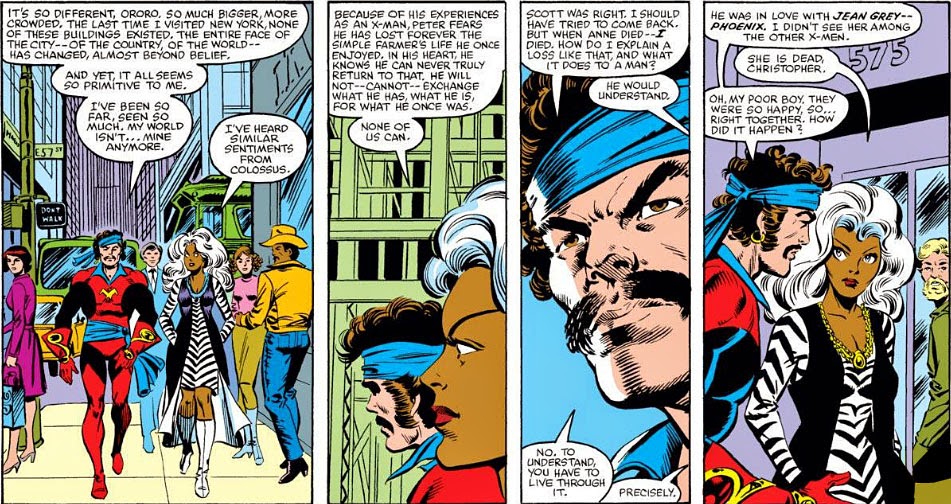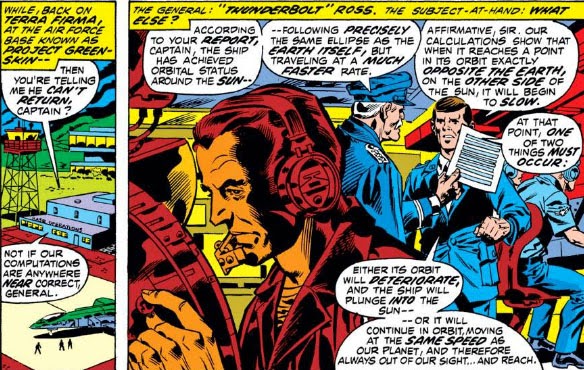We've followed the career of Major Glenn Talbot from when he
first arrived as the new security chief under General Ross's command, and watched as he progressed in his career while being instrumental in
discovering the true identity of the incredible Hulk. And through it all, he made an effort to grow closer to the General's daughter, Betty, even though she remained in love with Bruce Banner.
Talbot has been practically in Betty's orbit throughout her experiences with both Banner and the Hulk, seemingly to no avail. He was the textbook example of unrequited love--with Betty at times giving the impression that she was responding to Talbot's affections, but ultimately continuing to hope that Banner would one day be free of his curse as the Hulk so that they could finally be together. In short: Talbot had it bad for this gal, but never stood much of a chance while Banner continued to come between them, even mostly in absentia.
Yet, there came a time when Talbot's patience would finally be rewarded, when the Hulk was presumed dead after being reduced to ant size by exposure to Henry Pym's serum and subsequently crushed by the Chameleon. The news hits Betty like a sledge hammer:
But just look who springs up out of nowhere to seize the day:
This isn't the first time Banner has been mistaken for dead, of course--but, in an odd turn of events, Betty now accepts the news with finality and gives Talbot the green light. And, before you know it (really--just one issue later!), we find the two of them at a resort, with Talbot moving in for the kill and Betty all but responding with "Bruce
who??"
Betty is probably referring to Banner's growing affection for Jarella, the woman he met during a prior sub-atomic experience and whom he'd recently reconnected with. Jarella had the good fortune to establish a relationship with both Banner and the Hulk, though she was literally worlds apart from them--and so Banner enjoyed a unique relationship with her, something he'd also tried to have with Betty during the period he could control his transformations but which
ended in disaster. And so, while it may seem that Betty is writing off Banner rather quickly this time, in a way Jarella had made it possible for her to (as she says) see a future for herself without him. And as we've seen, Talbot was right there for the hand-off.
So are congratulations finally in order for Major Talbot? Is this where the guy finally gets the girl?
Well, yes and no. How dead do you think the Hulk is?
Since this is Henry Pym's serum we're talking about--or perhaps it's more appropriate to say,
Henry Pym we're talking about--we can assume the long-term stability of the serum the Hulk ingested is somewhat questionable. And so it's not long before we find the Hulk again growing his way back to our world, and finding himself in battle against the Rhino on a ship bound for the stars, thanks to the Leader. And Jim Wilson, witness to the event, is given the unenviable task of breaking the news to General Ross:
Ross, of course, is less than pleased at the thought of Betty's nuptials being disrupted by news that Bruce Banner is still alive. And so when the Hulk's ship heads for Counter-Earth, its trajectory is misinterpreted by a ground crew and gives Ross reason to cross his fingers:
Finally, then, the big day comes for Talbot--and certainly for Betty, who probably sleeps with a schematic of the altar underneath her pillow. Each of these people has been waiting for the same thing, although for different reasons:
Banner, however, doesn't stay on Counter-Earth too long (in an interesting story where he meets his "counter"part, who never became the Hulk), and he soon returns to our planet where Ross dogs his every move as the Hulk in an effort to keep Betty from discovering the truth. That takes both Ross and the Hulk to Russia, where Ross's task force is attacked by
the Gremlin and Ross is taken captive. And when that news hits the states, as well as news of the Hulk's involvement--well, let's just say that for Talbot and Betty, the honeymoon is over.
Come on, this wouldn't be Betty Ross if she weren't getting bad news of
some kind. But of course
this news hits Talbot a little harder, particularly finding out his commanding officer has been captured by (what was then) the U.S.S.R.
Later, a by-the-numbers career officer, Colonel John Armbruster, puts together a mission to retrieve Ross, which Talbot volunteers for. The mission is a success--for Ross, that is:
It would be a fitting end for Talbot--who perhaps didn't have anywhere further to go in this comic, other than to wrestle with Banner's return and its effect on Betty. But maybe there's still some life left in the old boy in the pages of
Incredible Hulk. The Soviets certainly seem to think so:
Betty, however, is inconsolable. She ends up blaming her father, as well as Bruce Banner, for the train wreck her life has become, and goes on to become
the Harpy before finally coming to terms with everything. That unfortunately doesn't translate to "happiness"--and when the Hulk is
again presumed dead, her grip on sanity still seems tenuous:
But if you think Major Talbot is going to be left out of all this drama, think again. Back in the U.S.S.R.
(© the Beatles, 1968), close to a year (our time) of being M.I.A. in the book, Talbot is revealed to be alive and appears to be escaping his imprisonment. Or
is he?
Betty, of course, is elated--in fact,
everyone seems pleased about Talbot's return, even the President. The one person who
doesn't seem like himself is the man of the hour:
Armbruster begins an informal, behind-the-scenes investigation of Talbot. Meanwhile, the Hulk has been captured and naturally brought to the containment facility named for him--which will certainly be a feather in Ross's cap for when the President visits. But soon, in the lower levels where Bruce Banner is being held, a meeting is taking place that's been long in coming:
It's a no-win situation for both of these people, though Betty obviously is making an effort to reach out to Banner and remain friends with him. We can assume that Banner is being drugged to some degree--otherwise his little outburst would end up "sharing" the Hulk with Betty much more than she had in mind.
But there's another outburst waiting in the wings, as Armbruster's investigation bears fruit and he arrives in the nick of time to spill the truth about Glenn Talbot:
It's curtains for Talbot and Armbruster, and the explosion is enough to trigger Banner's transformation to the Hulk and escape his confinement. But the shockwaves also affect two others at the scene:
This
really wouldn't be a good time for the Harpy to return, but Betty would have every reason to lose it at this point. Writers for
Incredible Hulk seems to find it almost irresistible to pile onto Betty Ross--it's like she has a "KICK ME" sign permanently attacked to her back. But we don't have much time to worry about Betty, because the base suddenly comes under attack by
the Devastator, a Soviet agent whose task was to make sure Talbot's mission wasn't compromised. With Talbot's cover blown (and how!), the Devastator does severe damage to the base before the Hulk finally stops him. However, in the aftermath, we discover that Glenn Talbot is a hard man to kill, especially when he's nowhere around:
Man, this book can yank our chain, can't it? It's no wonder Betty breaks down in tears so often--I feel like saying "move over" right now. The revelation about Talbot leads to a rescue operation quickly put together by Nick Fury, who's called in perpetually grinning SHIELD agent Clay Quatermain (whom we haven't seen since his old
Strange Tales days) to lead it:
Bitterfrost has more than its reputation in intelligence circles to prove daunting to a rescue mission, since it's also where the Gremlin is now based. But SHIELD isn't exactly chopped liver in intelligence matters or covert technology, and our crew is able to infiltrate the installation and locate Talbot, who appears to be a shadow of his former self:
With their presence discovered, the men race to make their way outside while the Hulk (who's stowed away on the mission as Banner) is keeping the Gremlin's forces occupied. (And if Bruce Banner can slip aboard your spy ship, it's probably time to review your security procedures.) What happens next is a little preposterous, since giving a loaded gun to a man in Talbot's condition seems the height of stupidity. But what goes around, comes around:
With everyone's capture (including the Hulk's), we finally learn how the real Glenn Talbot is still alive, though apparently in name only:
In time, though, Ross and his men make a break for it, thanks to the Hulk breaking out of captivity and shaking things up. But the Gremlin
hates leaving loose ends, particularly one who's a security risk:
Wow,
this should send Betty over a cliff, shouldn't it. "We brought Glenn back to you, but his mind is gone. Say hello to your husband in sickness and in health, Major Zombie!"
However, after some further analysis on Talbot, this time by psychiatrist Leonard Samson who's had dealings before with Ross and Banner (as well as with Betty--a popular girl, evidently), there seems to be cause for hope in reviving his mind. Naturally involving the one man in all of creation he wants to distance himself and Betty from:
Of course, getting Bruce Banner's help often means going through the Hulk first--and Samson, now returned to his "Doc Samson" form, tries to
retrieve the brute to no avail before finally succeeding in
an all-out battle that includes Quartermain and the forces of SHIELD. The plan is to shrink Banner (in the form of the Hulk, but retaining Banner's mind) into Talbot's brain so that he can locate and deal with the "mental block" that's keeping Talbot's subconscious from being reached. It doesn't all go according to plan, so it's rather the Hulk in all his savagery who deals with the blockage:
It takes some doing, but the shrunken Hulk is finally removed from Talbot's head and the man is given a clean bill of health. Unfortunately, that doesn't mean he and Betty are home-free as far as their marriage is concerned. Banner has his own problems, as both he and the Hulk deal with the recent death of Jarella; but as for Talbot, we see he's showing symptoms of PTSD from his ordeal:
It's a fitting place to leave Glenn Talbot at this point--mostly since you'd be hard-pressed to top that excellent exit narrative by writer Len Wein. When we conclude our profile of the Major, we'll see his differences with Bruce Banner and the Hulk escalate to the point of no return--and Talbot crosses the line between duty and vengeance.
(This post covers events from Incredible Hulk #s 155-206.)

















































































































































































































































































































